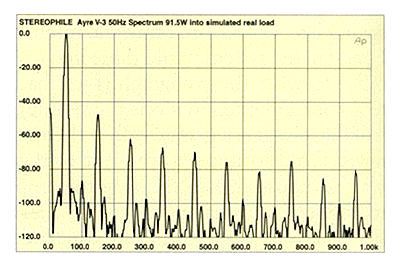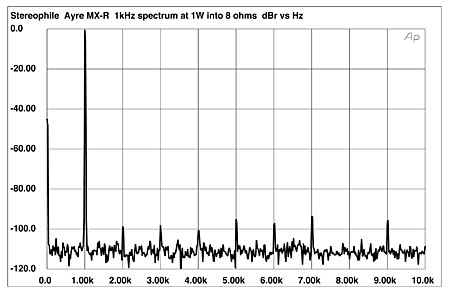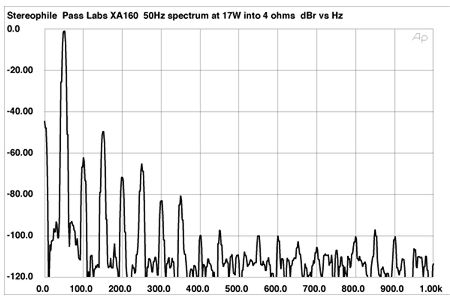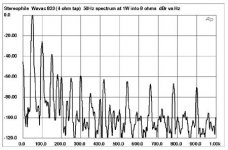For everyone, I have answered this question a number of times, over the years, and SE has ignored any substantive input that I have put forward. This has gone back and forth for more than 10 years between him and me, and it has little to do with 7th harmonic or its effects on musical reproduction. I offer here a piece of my experience that has been discussed by others for more than 75 years, in various publications, and I have found it useful. Certainly more useful than whether we measure some 2'nd or 3'rd harmonic distortion in a piece of audio equipment and want discuss its effects.
If this were 100 yrs ago (before amps), similiar arguments were taking place about where the hammer should strike the string on a piano in order to control the amount of 7th.
Harold A Conklin Jr: Piano design factors

You should have gone into politics. You're much better at giving non-answer answers to question than most.
Oh well. At least your hand-waving keeps the air in your apartment circulating.
se
Folks,
Nice data. I would not call two of these three amplifiers "Very Low Distortion", though all probably have low enough distortion. Also note that the Ayre MX-R plot is at 1 Watt while the Ayre V3 is at nearly 100 Watt, so at 20dB greater output.
If I compare Tube Amp's we often find less high order stuff, here an example of a "stereotypical" SE Tube Amp at 1 Watt into matched load:
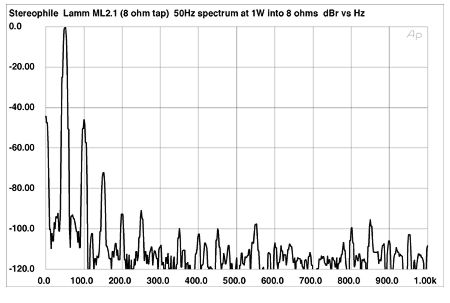
This SE Amp is rated at 18W so the 1W distortion shown here is moderately comparable to to the 17W for a 160W rated Amplifier as shown for the Pass XA-160.
If the power difference is compensated by selecting a suitably higher efficiency speaker (as is a must for SE Amp's) the respective harmonic content would happen at around equal SPL's, if we use an "average" efficiency 87dB/W/m Speaker for the Pass XA-160 it would be at 100dB SPL and if we used a 97dB/W/m speaker for the SE Amp it would be at 97dB SPL.
And here the distortion for a stereotypical Push-Pull Tube Amp:
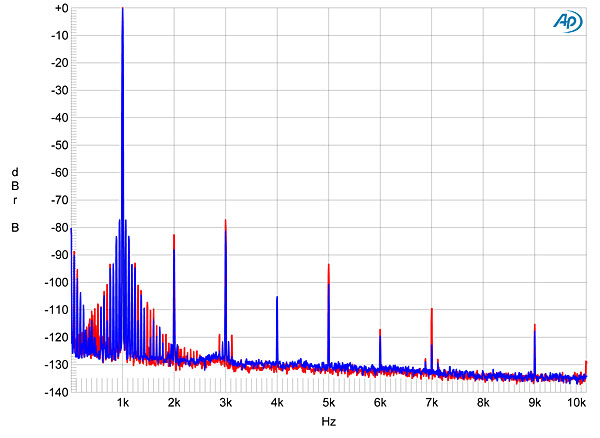
This is a 100W rated tube amp running at 10W into 8 Ohm, so again, as a percentage of rated power the power level tested is comparable to the Pass Amp.
For a true cabinet of Horrors on distortion (Audax Speaker users PLEASE do not look at this) this little Article has measurements of Speaker Distortion:

As we can see the woofer selected for the project has around 3% H2 at the tested level (not specified but probably at 2.83V input) pretty much across the board and 0.1% H3, at least other independent measurements of similar drivers by the Manufacturer show similar approximate levels.
Ciao T
the 7th of several well regarded amplifiers
Nice data. I would not call two of these three amplifiers "Very Low Distortion", though all probably have low enough distortion. Also note that the Ayre MX-R plot is at 1 Watt while the Ayre V3 is at nearly 100 Watt, so at 20dB greater output.
If I compare Tube Amp's we often find less high order stuff, here an example of a "stereotypical" SE Tube Amp at 1 Watt into matched load:

This SE Amp is rated at 18W so the 1W distortion shown here is moderately comparable to to the 17W for a 160W rated Amplifier as shown for the Pass XA-160.
If the power difference is compensated by selecting a suitably higher efficiency speaker (as is a must for SE Amp's) the respective harmonic content would happen at around equal SPL's, if we use an "average" efficiency 87dB/W/m Speaker for the Pass XA-160 it would be at 100dB SPL and if we used a 97dB/W/m speaker for the SE Amp it would be at 97dB SPL.
And here the distortion for a stereotypical Push-Pull Tube Amp:

This is a 100W rated tube amp running at 10W into 8 Ohm, so again, as a percentage of rated power the power level tested is comparable to the Pass Amp.
For a true cabinet of Horrors on distortion (Audax Speaker users PLEASE do not look at this) this little Article has measurements of Speaker Distortion:

As we can see the woofer selected for the project has around 3% H2 at the tested level (not specified but probably at 2.83V input) pretty much across the board and 0.1% H3, at least other independent measurements of similar drivers by the Manufacturer show similar approximate levels.
Ciao T
Last edited:
the 7th of several well regarded amplifiers:
.
.
.
.
They all look terrible.
Well PMA, it takes a lot of approaches to make an amplifier contest. Please use all the 7th and 9th harmonic that you want. It is just my approach to amplifier design that attempts to reduce 7th harmonic to -110dB or so, if I can.
Quote without comment:
"Some harmonics are dissonant with the fundamental and (unless at a very low level) are distinctly unpleasing to the listener as regards their direct effect, quite apart from their secondary effect on intermodulation." '7th, 9th, 11th ...' (from chart from the same page) pp. 606-607 'Radiotron Designers Handbook' RCA edition, 1953
Quote without comment:
"Some harmonics are dissonant with the fundamental and (unless at a very low level) are distinctly unpleasing to the listener as regards their direct effect, quite apart from their secondary effect on intermodulation." '7th, 9th, 11th ...' (from chart from the same page) pp. 606-607 'Radiotron Designers Handbook' RCA edition, 1953
And, of course, an amp that got high praise from John. My goodness, -75dB 7th is OK?
(image from Stereophile, Wavac SH-833 monoblock power amplifier Measurements | Stereophile.com)
(image from Stereophile, Wavac SH-833 monoblock power amplifier Measurements | Stereophile.com)
Attachments
When I listened to that amp, it was driving a full range horn, and probably had an output of no more that 100mW at the time, or 94dB or so. Perhaps it would have sounded very bad on a direct radiator speaker, given its distortion performance, but any Class A system has lower distortion by a predictable amount as output level is decreased.
I was referring to the praise heaped on an amp with, let's face it, pitiful performance and a stunning price tag, but all sorts of fashion cred. Your 7th harmonic criterion and the amp's actual performance is what led me to that.
Defending it by remarking that it might work better at 100mW is amazing to me.
Defending it by remarking that it might work better at 100mW is amazing to me.
Sy,
Every field has black sheep or simpletons who do not know better.
This is as true for High End audio as it fir example for the field of Plastics Chemistry. There are some very juicy stories of behaviour for which the word unethical is a very mild one indeed.
The problem is when because of some cases a whole field is targeted.
This would be like proclaiming that all companies engaged in plastics chemistry behave unethical and fraudulent, simply because one can bring one or two examples.
So with respect, I recommend to consider the old adage about people, glasshouses and stones.
Ciao T
So for $350k, we can keep the 7th down at 100mW. Maybe.
And you wonder why my attitude about High End audio is cynical?
Every field has black sheep or simpletons who do not know better.
This is as true for High End audio as it fir example for the field of Plastics Chemistry. There are some very juicy stories of behaviour for which the word unethical is a very mild one indeed.
The problem is when because of some cases a whole field is targeted.
This would be like proclaiming that all companies engaged in plastics chemistry behave unethical and fraudulent, simply because one can bring one or two examples.
So with respect, I recommend to consider the old adage about people, glasshouses and stones.
Ciao T
The mains sidebands are worse (possibly) than the Wavac. We talk about power supplies, grounding, etc. a lot, if the effect of these is not taken into account I figure these THD discussions are not very relevant.
Every field has black sheep or simpletons who do not know better.
So are you saying that there's merit in a $350k component with dreadful performance?
I don't follow your plastics chemistry analogy. In that field, data and performance are the drivers. You can't market a $1000/kilo plastic with lousy measured mechanical performance by claiming it made your toothbrush feel better.
[...]And you wonder why my attitude about High End audio is cynical?
I believe Thorsten meant that your attitude toward hig end audio should not be cynical because of a 350k amp which doesn't perform "well" according to a thd measurement (and of course some other examples).
There are quite a lot of "high end" manufacturers which deliver good performance and a fair price, so no reason to be cynical towards "the high end audio" per se......
There are quite a lot of "high end" manufacturers which deliver good performance and a fair price....
Some. Not a lot, IMO, especially the latter.
BTW, it wasn't a THD measurement, it was a full distortion spectrum. And as you alluded to, a horrifically poor and load-dependent frequency response.
When I once heard the Wavac by randomly visiting other listening rooms at CES, I was very impressed by the sound quality of the system. They were using Tannoy Westminster horn loaded speakers (I'm pretty sure), this big tube amp, and playing a record. It was Ella Fitzgerald singing 'September Song' that knocked me out. It was so realistic.
Much later I looked at the 'measurement' of one of the Wavac amps and was very surprised. It looked almost impossible to achieve such a bad measurement at just one watt output. Perhaps it was just a synergistic combination of the horn speaker and the amp that was the key. Since that ONE TIME, years ago, I have never heard the Wavac sound that good, but then they changed speakers, went digital source, etc. at later shows.
The price is 'obscene', but then just wait for the Japanese price of our new Constellation products to appear in stores. We are just as 'obscene' price-wise. Please remember that the Blowtorch cost 5 million yen, in Japan. That's pretty expensive too!
Now that I think about it, it would seem that the Japanese manufacturer, Wavac, probably could NOT lower its price from the Japanese one, even for sale in the USA, in order to protect its Japanese sales outlets.
Much later I looked at the 'measurement' of one of the Wavac amps and was very surprised. It looked almost impossible to achieve such a bad measurement at just one watt output. Perhaps it was just a synergistic combination of the horn speaker and the amp that was the key. Since that ONE TIME, years ago, I have never heard the Wavac sound that good, but then they changed speakers, went digital source, etc. at later shows.
The price is 'obscene', but then just wait for the Japanese price of our new Constellation products to appear in stores. We are just as 'obscene' price-wise. Please remember that the Blowtorch cost 5 million yen, in Japan. That's pretty expensive too!
Now that I think about it, it would seem that the Japanese manufacturer, Wavac, probably could NOT lower its price from the Japanese one, even for sale in the USA, in order to protect its Japanese sales outlets.
Last edited:
- Status
- Not open for further replies.
- Home
- Member Areas
- The Lounge
- John Curl's Blowtorch preamplifier part II
